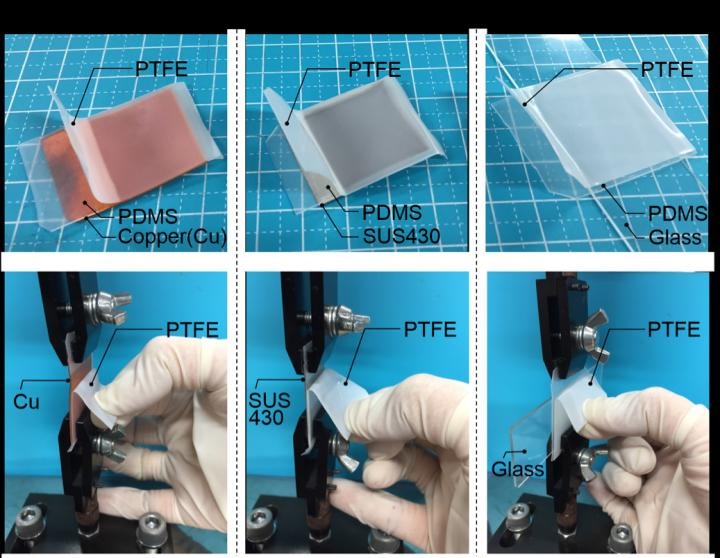Dec 27 2018
Polymers that contain plastics play a vital role in modern life. Since they are strong, lightweight, and unreactive, a wide array of technologies rely on them.
 Photograph of three-layer assemblies of (a) PTFE/PDMS/Cu, (b) PTFE/PDMS/SUS430, and (c) PTFE/PDMS/glass. When the PTFE or PDMS sheet was jerked and shaken, no peeling occurred at the interfaces of PTFE/PDMS, PDMS/Cu, PDMS/SUS430, and PDMS/glass. This shows that PJ-treated PDMS could be used as an alternative to strong adhesives to adhere fluoropolymers to other types of materials. (Image credit: Osaka University)
Photograph of three-layer assemblies of (a) PTFE/PDMS/Cu, (b) PTFE/PDMS/SUS430, and (c) PTFE/PDMS/glass. When the PTFE or PDMS sheet was jerked and shaken, no peeling occurred at the interfaces of PTFE/PDMS, PDMS/Cu, PDMS/SUS430, and PDMS/glass. This shows that PJ-treated PDMS could be used as an alternative to strong adhesives to adhere fluoropolymers to other types of materials. (Image credit: Osaka University)
Yet, a majority of the polymers do not adhere naturally to other materials; hence, they require corrosive chemical treatments or adhesives to be attached to other materials. This is a challenge in fields such as food and medicine, where it is necessary to avoid contamination by all means.
There is an emergent need for a clean method to make industrial polymers adhesive. Currently, researchers from Osaka University have accomplished just that. They have created a series of plasma treatments to enable the plastic PTFE (polytetrafluoroethylene) and vulcanized rubber to adhere to one another, or to other materials. The technique involves activating the surface chemistry of the polymers, as explained in a study published in Scientific Reports.
If you spray PTFE with a plasma of helium at 200 degrees, it can adhere to unvulcanized rubber—this is a technique we developed earlier in our lab. But vulcanized rubber presents a greater challenge. In our latest study, we customized a new plasma treatment for vulcanized silicone rubber, making it adhere strongly to PTFE for the first time.
Yuji Ohkubo, Study Lead Author, Osaka University.
The silicone under discussion was PDMS (polydimethylsiloxane), a familiar resin. While the major advancement in PTFE adhesion was the heat-assisted plasma treatment, the trick with PDMS is to blow up the surface using a plasma jet, by forcing nitrogen/air plasma through a small hole. The silicon-carbon bonds on the surface are broken by the jet and converted into silanol (Si-OH).
These silanol groups are more reactive compared to the original silicone surface and can adhere to PTFE. Hydrogen bonds are formed between silanol and the oxygen-containing functional groups on the treated PTFE under high pressure. Strong covalent bonds (C-O-Si, where C comes from PTFE and Si from silicone) further combine the two polymers together, even though there is no adhesive.
Stitching the two materials enables each to enjoy the advantages of the other—the dirt-repellent, chemical resistance, and slide-ability of PTFE, and the elasticity of silicone. It is also possible to replace opaque PTFE with perfluoroalkoxy alkane (PFA) in case transparency is required. Moreover, this is not just the end—upon plasma-jetting the reverse side of the PDMS, it can adhere to copper and even glass. Similar to an exceptionally strong double-sided tape, this three-layer sandwich enables the fluoropolymers to adhere cleanly to other useful materials.
PDMS is widely used in medicine, for example in microfluidic chips. There could be huge benefits in making both PTFE and PDMS more versatile for medical and food technologies through adhesive-free adhesion. Combined with the lack of any need for volatile chemicals, we hope our method will broaden the horizons for polymers in high technology.
Katsuyoshi Endo, Study Co-author, Osaka University.